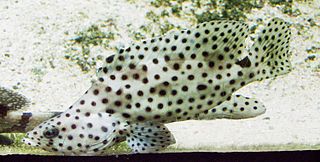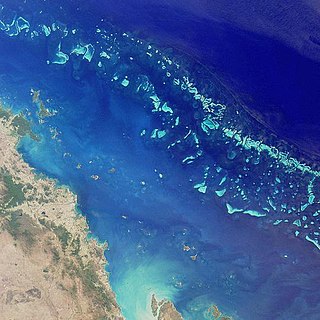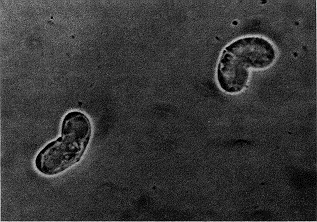
The Serranidae are a large family of fishes belonging to the order Perciformes. The family contains about 450 species in 65 genera, including the sea basses and the groupers. Although many species are small, in some cases less than 10 cm (3.9 in), the giant grouper is one of the largest bony fishes in the world, growing to 2.7 m in length and 400 kg (880 lb) in weight. Representatives of this group live in tropical and subtropical seas worldwide.

The Great Barrier Reef is the world's largest coral reef system composed of over 2,900 individual reefs and 900 islands stretching for over 2,300 kilometres (1,400 mi) over an area of approximately 344,400 square kilometres (133,000 sq mi). The reef is located in the Coral Sea, off the coast of Queensland, Australia. The Great Barrier Reef can be seen from outer space and is the world's biggest single structure made by living organisms. This reef structure is composed of and built by billions of tiny organisms, known as coral polyps. It supports a wide diversity of life and was selected as a World Heritage Site in 1981. CNN labelled it one of the seven natural wonders of the world in 1997. Australian World Heritage places included it in its list in 2007. The Queensland National Trust named it a state icon of Queensland in 2006.

The Coral Sea is a marginal sea of the South Pacific off the northeast coast of Australia, and classified as an interim Australian bioregion. The Coral Sea extends 2,000 kilometres (1,200 mi) down the Australian northeast coast. The sea was the location for the Battle of the Coral Sea, a major confrontation during World War II between the navies of the Empire of Japan, and the United States and Australia.

Ceratonova shasta is a myxosporean parasite that infects salmonid fish on the Pacific coast of North America. It was first observed at the Crystal Lake Hatchery, Shasta County, California, and has now been reported from Idaho, Oregon, Washington, British Columbia and Alaska.

Bivalvulida is an order of myxosporean parasites which contains a number of species which cause economically significant losses to aquaculture and fisheries, such as Myxobolus cerebralis and Ceratomyxa shasta. The Myxosporean stages of members of the bivalvulida are characterised by their two spore valves, which meet in a "suture line" which encircles the spore. They usually contain two polar capsules, but species have been reported which contain either one or four.

The ring-tailed cardinalfish is a widespread fish species in the family Apogonidae found in the Red Sea and off East Africa to Papua New Guinea, north to Japan, and south to Australia.

The potato grouper, also called the potato cod or potato bass, is a species of marine ray-finned fish, a grouper from the subfamily Epinephelinae which is part of the family Serranidae, which also includes the anthias and sea basses. It has a wide Indo-Pacific distribution.

The golden grouper, also known as the pink grouper or Powell's grouper, is a species of marine ray-finned fish, a grouper from the subfamily Epinephelinae which is part of the family Serranidae, which also includes the anthias and sea basses. It is found in the eastern Indian Ocean and Western Pacific Ocean.

Ostorhinchus cyanosoma, commonly known as the yellow-striped cardinalfish, goldenstriped cardinalfish, or the orange-lined cardinalfish, is a species of marine fish in the cardinalfish family of order Perciformes. It is native to the Indo-West Pacific.
Ceratomyxa is a genus of myxozoan.

Ceratomyxidae is a family of myxozoans.

The Barrier Reef chromis, also known as the yellowback puller or shining puller, is a species of damselfish in the family Pomacentridae native to the east coast of Australia. It is a small fish with a yellowish-brown dorsal surface separated by a dark stripe from its silvery flanks and underside.
Anilocra pomacentri is a species of marine isopod in the family Cymothoidae. It is found off the coast of eastern Australia and is an external parasite of the yellowback puller, a species of damselfish. The presence of the parasite on a fish causes a significant slowing of the growth rate and an increased mortality.
Ceratomyxa cutmorei is a myxosporean parasite that infects gall-bladders of serranid fishes from the Great Barrier Reef. It was first found on Epinephelus fasciatus.
Ceratomyxa gleesoni is a myxosporean parasite that infects gall-bladders of serranid fishes from the Great Barrier Reef. It was first found on Plectropomus leopardus.
Ceratomyxa hooperi is a myxosporean parasite that infects gall-bladders of serranid fishes from the Great Barrier Reef. It was first found on Epinephelus quoyanus.
Ceratomyxa nolani is a myxosporean parasite that infects gall-bladders of serranid fishes from the Great Barrier Reef. It was first found on Epinephelus quoyanus.
Ceratomyxa whippsi is a myxosporean parasite that infects gall-bladders of serranid fishes from the Great Barrier Reef. It was first found on Cephalopholis boenak.
Ceratomyxa yokoyamai is a myxosporean parasite that infects gall-bladders of serranid fishes from the Great Barrier Reef. It was first found on Epinephelus maculatus.
Pseudorhabdosynochus youngi is species of diplectanid monogenean parasitic on the gills of the blacktip grouper, Epinephelus fasciatus. It was described in 2009.










